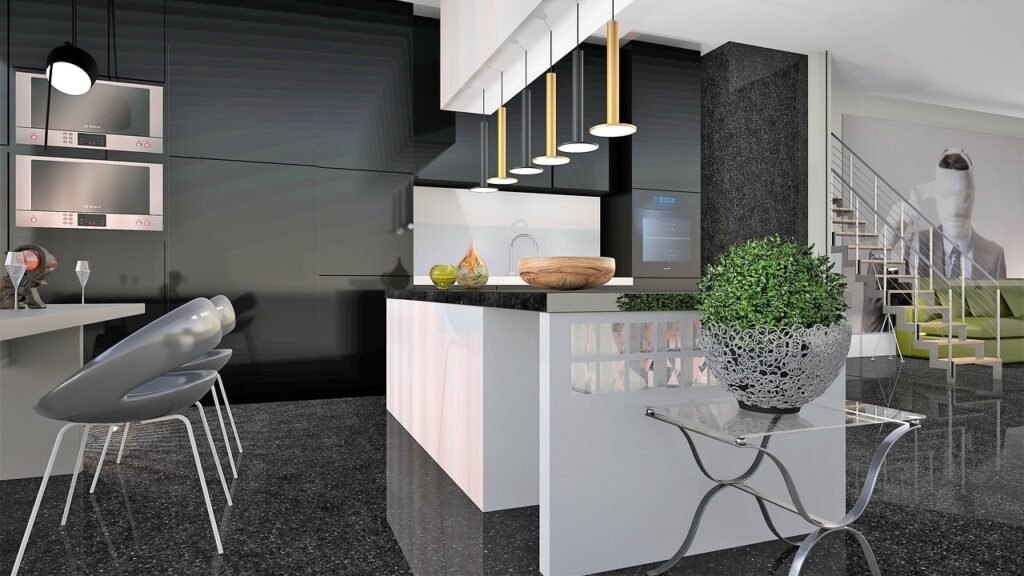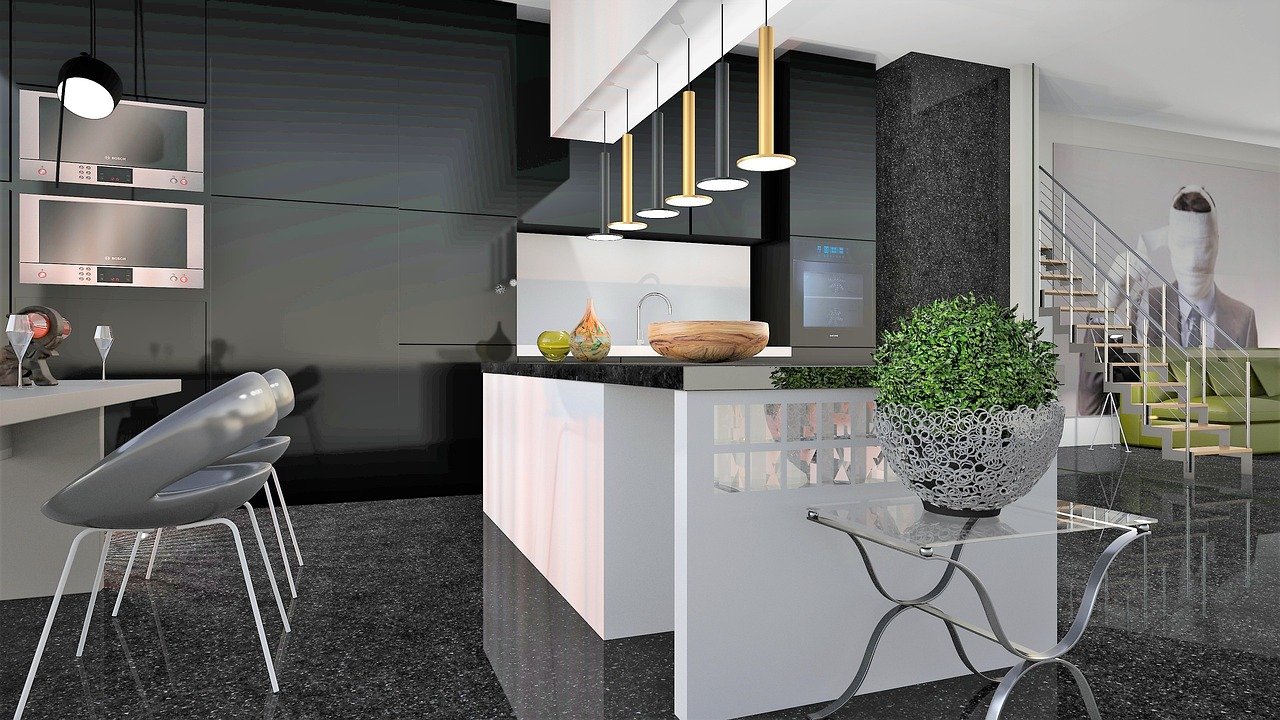If you want to create a warm and inviting atmosphere in your kitchen, maximizing illumination is key. A clever way to achieve this is by layering lights in your kitchen areas. By strategically combining different types of lighting, such as ambient, task, and accent lighting, you can create a visually appealing and functional space that caters to all your cooking and entertaining needs. In this article, we will explore the benefits and techniques of layering lights in kitchen spaces, providing you with practical tips to bring a radiant glow into your culinary haven.
Importance of Illumination in Kitchen Areas
Visibility and safety
Proper illumination is crucial in kitchen areas to ensure visibility and safety. A well-lit kitchen allows you to perform various tasks with ease, such as chopping vegetables, reading recipes, and checking the doneness of food. Adequate lighting helps reduce the risk of accidents and injuries by minimizing the chances of cutting yourself or stumbling over objects. By ensuring that every corner of your kitchen is well-lit, you can confidently move around and complete your cooking activities without any hindrances.
Enhancing the aesthetics
Besides the practical benefits, lighting in kitchen areas also plays a significant role in enhancing the overall aesthetics of the space. Thoughtfully chosen light fixtures can add a touch of style and elegance to your kitchen, transforming it from a mundane cooking area into a warm and inviting space. By strategically illuminating key features, such as countertops, kitchen cabinets, and backsplashes, you can create visual interest and make your kitchen look visually appealing.
Creating a welcoming ambiance
In addition to functionality and aesthetics, lighting also contributes to the creation of a welcoming ambiance in your kitchen. The right combination of lighting can set the mood and atmosphere, making the space feel cozy, inviting, and comfortable. Whether it’s preparing a romantic dinner for two or hosting a lively dinner party, having control over the lighting allows you to create the perfect ambiance for any occasion. With well-designed illumination, your kitchen becomes a versatile space that can adapt to various social gatherings and family activities.
Understanding Layering Lights
Definition and concept
Layering lights in the kitchen involves the strategic placement of multiple light sources to create a well-balanced lighting scheme. This concept revolves around the idea of using different types of lighting fixtures, such as task lighting, ambient lighting, and accent lighting, to fulfill various lighting needs and achieve optimal illumination throughout the kitchen area. By layering lights, you can achieve functional, aesthetically pleasing, and customizable lighting solutions that cater to your specific requirements.
Types of lighting layers
Layering lights typically involves three main types of lighting layers: task lighting, ambient lighting, and accent lighting. Task lighting focuses on providing bright, concentrated light to specific work areas, such as countertops, stovetops, and sinks. Ambient lighting, on the other hand, serves as the overall illumination of the kitchen space, providing general lighting and evenly distributing light throughout the room. Accent lighting is used to add visual interest and highlight specific features, such as artwork, architectural details, or decorative items.

This image is property of pixabay.com.
Task Lighting
Purpose and placement
Task lighting is essential for performing specific tasks in the kitchen, such as food preparation, cooking, and cleaning. It helps eliminate shadows and provides focused illumination exactly where you need it the most. Proper placement of task lighting fixtures is crucial to ensure optimal functionality. Under-cabinet lights are commonly used to illuminate countertops, while pendant lights above the kitchen island or a task light above the sink can provide task-specific lighting in those areas.
Recommendations for task lighting fixtures
When choosing task lighting fixtures for your kitchen, consider fixtures that offer bright, concentrated light, such as LED strip lights or adjustable spotlights. These fixtures provide ample illumination without creating harsh shadows. Additionally, look for fixtures with adjustable angles or dimming capabilities to customize the lighting intensity based on your specific tasks and preferences. Remember to choose fixtures that complement the overall design and style of your kitchen for a cohesive look.
Ambient Lighting
Function and positioning
Ambient lighting serves as the primary source of general illumination in the kitchen. Unlike task lighting, ambient lighting provides uniform and soft light that fills the entire space, ensuring that every corner of your kitchen is well-lit. It creates a warm and inviting environment, making it easier to navigate and work in your kitchen. Ambient lighting is typically achieved through a combination of ceiling-mounted fixtures, such as recessed lights or track lighting, that are evenly distributed throughout the room.
Suggested ambient lighting options
To achieve effective ambient lighting in your kitchen, consider installing overhead fixtures that provide an even spread of light. Recessed lights or flush-mounted ceiling fixtures are popular choices for ambient lighting as they blend seamlessly with the ceiling and distribute light without causing glare. Another option is track lighting, which allows you to adjust the direction of the light to suit different areas in the kitchen. By incorporating dimmer switches, you can further control the intensity of the ambient lighting to create the desired ambiance.

This image is property of pixabay.com.
Accent Lighting
Adding visual interest
Accent lighting is an excellent way to add visual interest and create a focal point in your kitchen. By highlighting specific areas or features, accent lighting draws attention and adds a touch of drama to the space. It can illuminate architectural details, such as exposed brick walls or decorative beams, creating a visually appealing backdrop. Additionally, accent lighting can be used to showcase artwork, decorative items, or even a collection of cookware, adding a personal touch to your kitchen.
Highlighting architectural features
If your kitchen boasts unique architectural features, such as a decorative ceiling, arches, or columns, accent lighting can help emphasize and enhance their beauty. Installed strategically, these lights create a subtle interplay of light and shadows, adding depth and dimension to the space. By using spotlights or wall-mounted fixtures, you can effectively highlight these distinctive architectural elements, making them stand out and becoming the focal point of your kitchen’s design.
Accentuating decor and artwork
If you have artwork or decorative pieces displayed in your kitchen, accent lighting can make them shine. By directing a focused beam of light onto these items, you can create a gallery-like effect and draw attention to their beauty. Accent lighting fixtures such as picture lights or adjustable track lights can be used to illuminate artwork, a collection of photographs, or sculptures. This not only adds visual interest but also allows you to showcase your personal style and taste within your kitchen space.
Choosing Light Fixtures for Layering
Considering kitchen layout and design
When selecting light fixtures for layering in your kitchen, it’s important to consider the layout and design of the space. Take into account the size and shape of your kitchen, as well as the location of key features and work areas. Make sure the fixtures you choose complement the overall style and aesthetics of your kitchen. For example, if you have a modern kitchen, you may prefer sleek and minimalist fixtures, whereas a farmhouse-style kitchen may benefit from rustic or vintage-inspired lighting choices.
Matching light fixtures with the overall style
To maintain a cohesive and harmonious look in your kitchen, it’s essential to choose light fixtures that match the overall style and theme of the space. Consider the materials, finishes, and shapes of your fixtures and ensure they align with the existing elements in your kitchen, such as cabinet hardware, faucet, and appliances. By selecting fixtures that cohesively blend with the overall design, you can create a visually appealing and well-orchestrated kitchen lighting scheme.

This image is property of pixabay.com.
Optimizing Natural Light
Maximizing sunlight penetration
Natural light is an invaluable asset when it comes to kitchen illumination. It not only provides energy-efficient lighting but also enhances the overall ambiance. To optimize the natural light in your kitchen, ensure that your windows are unobstructed and free from heavy curtains or blinds that might hinder sunlight penetration. Consider installing large windows or skylights, if possible, to maximize the amount of natural light flooding into your kitchen.
Window treatments for controlled illumination
While maximizing natural light is desirable, sometimes you may want to control the amount of light entering your kitchen to minimize glare or protect sensitive materials from harmful UV rays. In such cases, consider incorporating window treatments that allow you to adjust the level of illumination. Sheer curtains, blinds, or shades with adjustable slats are excellent options as they provide privacy and control the amount of light entering your kitchen while still allowing natural light to filter through.
Lighting Control Systems
Benefits of automated lighting
Installing a lighting control system in your kitchen can provide numerous benefits. Automated lighting allows you to control the intensity, color, and even the timing of your lights, providing ultimate convenience and versatility. With the touch of a button or through a smartphone app, you can adjust the lighting levels based on your activities, create preset lighting scenes for different occasions, and even remotely control your kitchen lights when you’re away.
Integration with smart home technology
Integrating your kitchen lighting with smart home technology opens up a world of possibilities. Through voice commands or a smart home hub, you can control your kitchen’s lighting effortlessly. You can synchronize your lighting with other smart devices, such as motion sensors or voice assistants, creating a seamless and intuitive lighting experience. Additionally, smart lighting systems often offer energy-saving features, enabling you to optimize energy usage and reduce your carbon footprint.
Energy Efficiency and Sustainability
Choosing energy-efficient lighting options
In today’s environmentally conscious world, choosing energy-efficient lighting options for your kitchen is not only beneficial for the planet but also for your wallet. Opt for light fixtures that utilize LED (light-emitting diode) technology as they consume significantly less energy and last longer compared to traditional incandescent or fluorescent bulbs. LED bulbs also produce less heat, reducing the strain on your kitchen’s cooling system. By selecting energy-efficient fixtures, you can significantly reduce your energy consumption and lower your electricity bills.
Utilizing eco-friendly materials
When it comes to sustainability, not only should you consider energy-efficient lighting options, but also the materials used in your light fixtures. Look for fixtures made from eco-friendly materials, such as recycled metals or sustainably sourced wood. Similarly, opt for light diffusers or lampshades made from natural materials, like bamboo or fabric, instead of plastic. By choosing fixtures that are both energy-efficient and made from sustainable materials, you can make a positive impact on the environment while enjoying a well-lit and eco-friendly kitchen.
Tips for Effective Kitchen Lighting
Balancing light sources
To achieve optimal lighting in your kitchen, it’s important to strike a balance between different light sources. The combination of task, ambient, and accent lighting should work harmoniously to provide the right amount of illumination throughout the space. Avoid relying too heavily on a single type of lighting, as it can create harsh shadows or uneven lighting distribution. By layering different lighting types, you can achieve a well-balanced and visually pleasing kitchen lighting design.
Avoiding glare and shadows
Glare and shadows can be major hurdles in achieving effective kitchen lighting. To minimize glare, ensure that your light fixtures are properly positioned and shielded to prevent direct light from hitting your eyes or reflective surfaces. Use diffusers, frosted bulbs, or adjustable fixtures to soften the light and reduce glare. Additionally, minimize shadows by strategically placing task lighting fixtures to eliminate any dark spots on countertops, sinks, or stovetops. You can also utilize reflective surfaces, such as stainless steel appliances or glossy backsplashes, to bounce light and reduce shadows.
Adjusting lighting levels based on tasks
Different kitchen tasks require varying levels of lighting. While bright and focused lighting is essential for tasks like food preparation and cooking, softer and dimmer lighting may be more suitable for relaxed dining or entertaining. Consider installing dimmer switches or using smart lighting controls to adjust the lighting levels based on your specific activities and moods. This flexibility allows you to customize the ambiance and functionality of your kitchen, making it a versatile space that caters to your ever-changing needs.
In conclusion, proper illumination in kitchen areas is vital for visibility, safety, and overall aesthetics. By layering lights through task lighting, ambient lighting, and accent lighting, you can achieve a well-balanced and visually pleasing lighting scheme that enhances your kitchen experience. Consider the layout and design of your kitchen, choose light fixtures that complement your style, optimize natural light, and explore energy-efficient and sustainable lighting options. Remember to balance different light sources, minimize glare and shadows, and adjust lighting levels based on tasks to create an effective and inviting kitchen environment.
